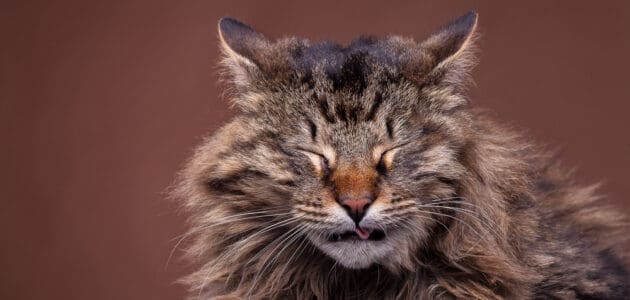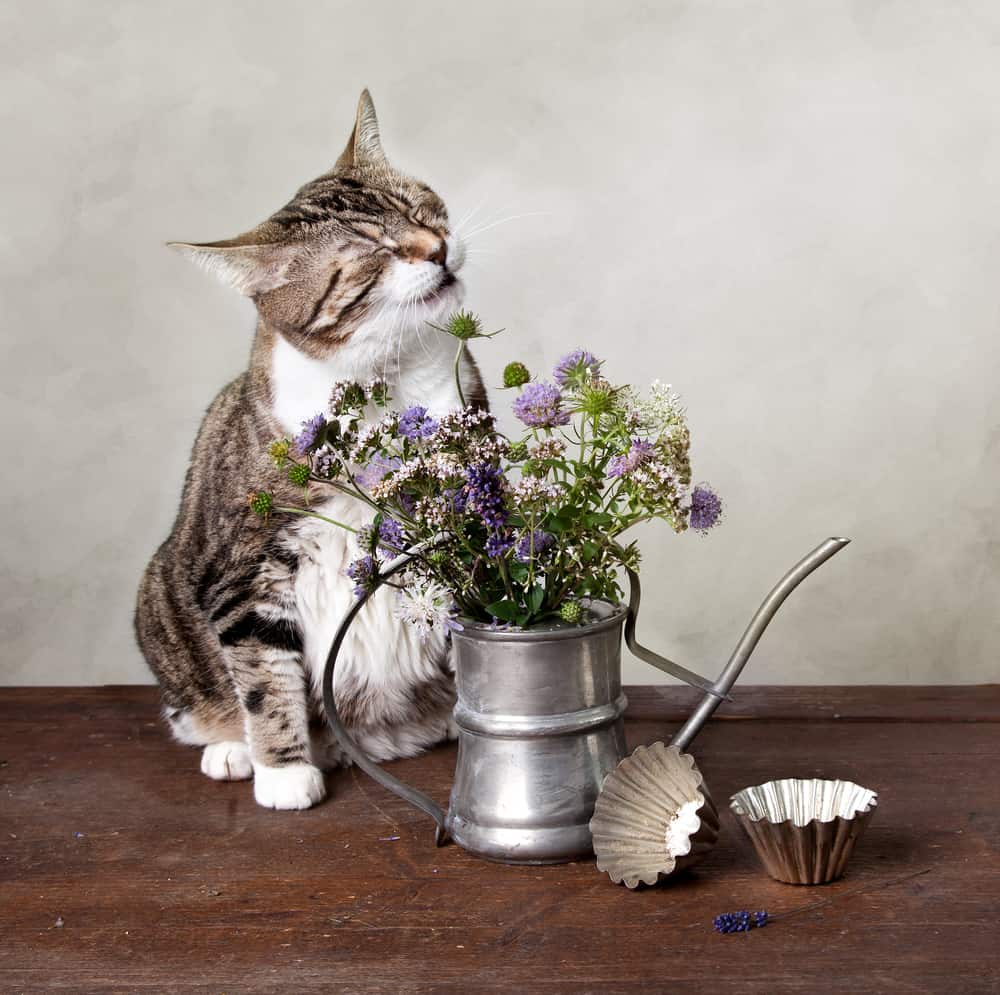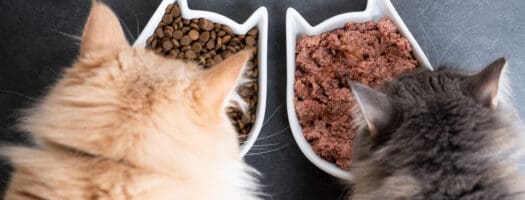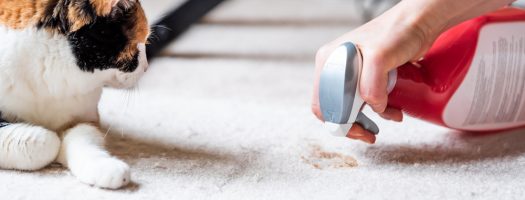Cat Sneezing Blood? Understanding the Causes and Treatment Options

If you have discovered that your cat is sneezing blood, it can be quite scary (and more than a little messy). Fortunately, this is not nearly as uncommon as most people would think, and in most cases, it is not an indication of a serious issue.
However, if you notice your cat sneezing blood, you will need to take them to the vet. This is to confirm that it is nothing to be worried about (a few more serious causes, which we will cover below require urgent care), or to perform a simple treatment to address the problem.
What Causes a Cat to Sneeze Blood?
There are many things that can cause your cat to sneeze blood. Below you will find the most common issues that can result in blood in the nose, which would be expelled with a sneeze. Also listed are some basic treatment options that you or your vet may use.
For more serious problems, read through the section on how a vet treats cats sneezing blood at the bottom of this page.
Respiratory Tract Infection
Just like humans, cats can get respiratory tract infections. They are typically caused by a virus, and can cause coughing, sneezing, and other symptoms for several days. In some cases, the sneezing will irritate the respiratory tract or an area in their nose, and cause bleeding. The blood will then spray out with each sneeze. This is more common in very dry climates or seasons, which can make their nose more susceptible to bleeding.
If you are confident that the bloody sneezing is caused by a simple cold, you can try to provide relief at home. This can be done by increasing the humidity in the air. One way to do this is by locking them in a steamy bathroom for 5-10 minutes at a time, several times per day. If you have a humidifier, you can run that throughout the house to provide relief.
Foreign Body in the Nose or Nasal Cavity
Cats are often very playful and curious animals, which is one of the reasons we love them. If your cat is playing with a toy, a stick, or even a mouse, it can expose them to some risk of a foreign object entering their nose.
If a sliver of a stick, a mouse claw, or even a blade of grass gets lodged in their nose, it can result in significant irritation. Your cat may try to get it out with their claws, which could result in bleeding. The irritation itself could also result in bleeding. If your cat is bleeding in their nose or nasal cavity, it will trigger the sneezing reaction to get the blood out.
Your cat may eventually be able to get the foreign body out on their own, but if the bleeding continues for more than a day or so, or it becomes heavy, they definitely need to visit the vet. Your vet will be able to look in your cat’s nose and remove whatever is causing the problem.
Ideally though, the cat should be taken the vet as soon as possible; an object stuck in your cat’s nose, even if it’s not especially dangerous, can cause significant pain and discomfort.
Chemical Irritants
Your cat is likely exposed to a variety of different chemicals on a regular basis. This could be cleaning chemicals, perfumes, air fresheners, or any number of other things. Since your cat is lower to the ground, and they are constantly sniffing things, the level of exposure to even normally safe chemicals could cause problems.
Chemical exposure could result in inflammation in the membranes in your cat’s nasal cavity. This will cause your cat to sneeze to try to expel the irritants. If the inflammation or irritation is significant enough, a cut or abscess could result in bleeding.
If you are able to pinpoint what chemical is causing the irritation by identifying when it occurs, the obvious solution is to stop using that chemical or take steps to keep your cat away from it.
In most cases, however, it is difficult to confirm chemical exposure on your own. If you bring your cat to the vet, they may be able to see the inflammation throughout the nose and nasal cavity. They could also take a mucous sample and run tests on it to figure out what the cause might be.
Physical Injury
Cats love to fight. This could be a playful fight with another cat, or a hunting exercise with mice, moles, or other animals. Anytime your cat is fighting, they are at risk of getting scratched or bitten, and it is definitely possible that the injury occurs near or even in the nose.
The initial injury will likely scab over within minutes but may result in ongoing irritation. As the healing process continues, it can cause itching and other discomforts, which can cause sneezing. Anytime the scab comes loose, there will be some bleeding and sneezing.
For minor injuries, there is nothing that needs to be done for treatment. Your cat will heal within a few days to the point where they are no longer at risk of bleeding. For deep cuts or constant bleeding, however, a trip to the vet will be necessary.
Your vet can look closely at the injury and take the appropriate steps to heal it. This may include giving your cat stitches, applying a healing cream, or applying an ointment that prevents itching. The goal with any treatment of an injury on or in the nose is to keep it from getting infected and allow the natural healing process to take place.
Allergies
Allergies are very common in felines, especially those who live indoors. If your cat is regularly exposed to certain allergens, they can cough and sneeze quite a bit. Over time, this can lead to irritation of their nose and nasal cavity, which may result in bleeding.

To prevent this, you will want to figure out what is causing the allergic reaction. Just like humans, cats can be allergic to foods, seasonal contaminants, dust, and more. If you cannot figure it out on your own, schedule an appointment with your vet to see if they can do an allergy test to identify the cause of the problem.
There are several blood-related illnesses that your cat can suffer from, including high blood pressure, a clotting disorder, or anemia. One of the signs of such issues can be bleeding while sneezing, so you’ll want to keep a close eye out for any other symptoms.
If you notice your cat has a lack of energy, blood in their feces, changes in their appetite, or has been vomiting, they may have an issue with their blood. The only way to be certain is to take them to a vet and have them examined.
Additionally, if your cat gets into certain toxins, like those present in rat poisons, it may result in blood issues that cause bleeding while sneezing. Keep in mind that there doesn’t have to be rat poison in your home for this to happen; your cat can also become ill if they catch a rat who has ingested poison while somewhere else.
If your cat is suffering from ingesting a poison, it’s vital to get them treated right away; if not dealt with promptly, rat poison can be fatal for cats. To be safe, you’ll want to immediately take your cat to a vet if you notice your cat sneeing blood.
Tumor
A tumor or other growth on or in the nose can easily result in bloody sneezing. The tumor may rupture, causing bleeding. It is also possible that it will put additional pressure on the blood vessels in the nose, which could cause bleeding.
If there is a growth on your cat, it is important to bring them to the vet to have it looked at right away. Many growths are benign and not dangerous at all. These can either be left alone or removed surgically. It may also be possible to use topical medication to either shrink the growth or close up any wounds it has caused to prevent the bleeding.
If the tumor is cancerous, your vet will need to determine if it has spread anywhere else in the body. They will then want to remove it surgically to ensure it does not continue to grow or spread, which could be deadly.
Dental Issues
Just because a cat is sneezing blood does not mean that the source of the problem is in the nose. It is not uncommon for a cat to have dental issues, which can trigger sneezing blood. If their gums or other areas of the mouth are bleeding, the blood could irritate the back of the throat, triggering a sneeze. Droplets of the blood from the mouth would then get expelled.
Another possibility is that your cat has an infection at the root of one or more of their teeth. If this is the case, the infection may lead to bacteria entering the nasal cavity. The bacteria may cause bleeding either around the root of the tooth or in the nasal cavity.
How a Vet Treats a Cat Sneezing Blood
In most cases, your cat’s bloody sneezing issues will resolve themselves on their own; it is always a good idea to have them seen by a veterinarian just to be safe.
When you bring your cat into your vet, they will likely perform a number of different tests. These tests will help to identify the cause of the blood in your cats’ nose, so it can be treated. Some of the most common tests for this type of issue include the following.
Full Physical Examination
While sneezing blood is a symptom specifically on the nose, your vet will likely want to do a full physical examination. This may allow them to identify a larger health problem that is displaying with blood in the nose. For example, if your cat is allergic to the food they are eating, your vet may find significant bloating in the stomach or issues in their stool.
A full physical examination will also help them to identify any issues with their mouth, throat, or other areas that may result in blood entering the nasal cavities.
Visual Inspection of the Nose and Nasal Cavity
It is very likely that your vet will perform a visual inspection of the area around the nose as well as in the nasal cavity. This will start with the vet using a magnifying tool and light that will allow them to see any small abrasions, cuts, or irritation on the nose and just inside it.
If they do not discover the problem there, they will typically perform a rhinoscopy. This is where they place a small camera and light into the nasal cavity. It will transmit an image to a screen so the vet can look for signs of physical damage, infection, or other issues. If this test is needed, they will likely have to sedate your cat to keep them still and safe.
Biopsy
If your vet finds a tumor or growth, they will almost certainly want to take a biopsy if they aren’t able to remove it immediately. This is a process where they cut off a small portion of the growth so it can be analyzed. This will determine whether the growth is cancer or something else.
The treatment options for a growth in your cat’s nose will depend largely on the results of this analysis.
Blood and Urine Tests
Blood and urine tests may be needed if the vet cannot see any obvious source for the blood. These tests can look for more serious diseases like cancer, diabetes, and much more. Once your vet collects the blood or urine needed for the test, it will be sent off to a lab for analysis, which can take a few days.
Once the results are back, you should have a reliable diagnosis and treatment options available.
Cats Sneezing Blood Usually Looks Worse Than It Is
A cat sneezing blood can be a very scary thing. Since cats typically roam throughout the house and are not careful where they sneeze, it can also be a very messy problem to have to deal with. Thankfully, in the vast majority of cases, your cat will not have anything that is seriously wrong with them.
With a little investigation and some help from your vet, you will be able to find the root cause of the blood and get it taken care of right away. This will allow you and your cat to continue living a long and healthy life, without having to worry about blood on the walls, furniture, and floors.




